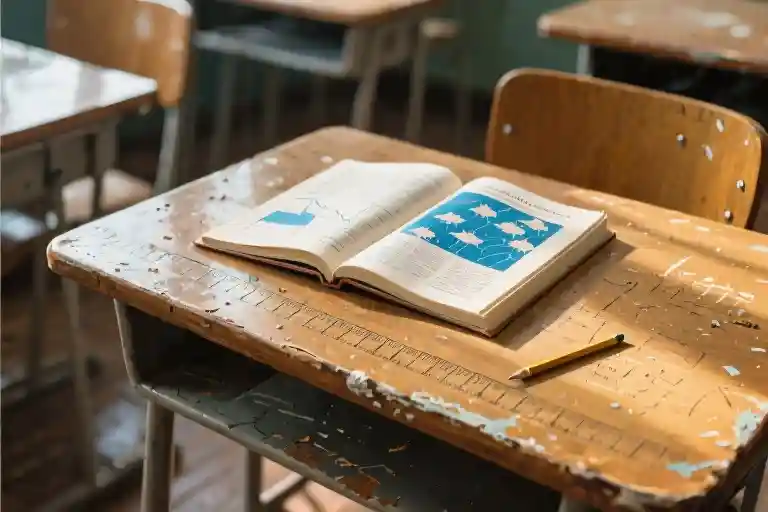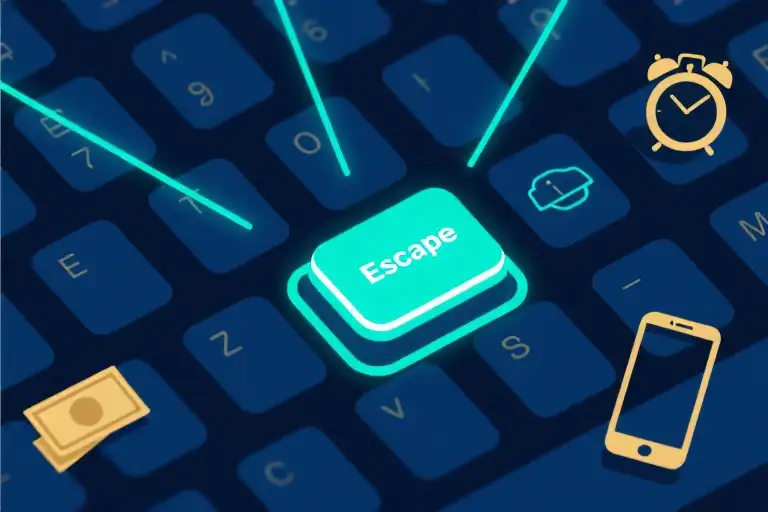The sharp crack of wood against wood echoes through the classroom before I even register the sting in my elbows. My chair legs scrape concrete as I jerk backward, the sudden movement sending my pencil rolling off the desk in slow motion. Laughter ripples across the room like wind through wheat fields – that particular brand of childhood schadenfreude reserved for minor disasters.
Sister Catherine’s ruler hovers mid-air, its edge still vibrating from the impact. Her lips press into that familiar line somewhere between amusement and exasperation, the one that always precedes my name in that tone. ‘Since your head is always in the clouds,’ she says, tapping the open textbook before me, ‘perhaps you’ll educate us about them. Beginning at “Atmosphere, Weather, and Climate.”‘
My voice stumbles through the paragraphs about cumulus formations and barometric pressure while my mind tracks the second hand’s progress across the clock face. The words dissolve into meaningless shapes as I read, my tongue moving independently of my comprehension. When Sister Catherine finally nods and moves down the row, I exhale the breath I didn’t realize I’d been holding.
This scene will crystallize into another three-line verdict on my report card, that haiku of faint praise and gentle admonishment that follows me like a shadow:
Has great potential
Needs to apply herself more
Easily distracted
These seventeen syllables collect under my tongue like copper pennies, their metallic aftertaste seeping into my bloodstream. The distance between who I am and who I might be stretches before me like a tightrope, and I wobble precariously between the two with every step.
Some part of me strains forward like a pointer dog catching scent, nose quivering toward some glorious horizon of achievement. But my attention? That’s a feral creature all its own – all arched back and puffed tail, hissing at any attempt at domestication. The struggle leaves me breathless, my inner landscape littered with the scratches of good intentions gone awry.
And always, always, those dreams just beyond reach – scattering like startled birds at the slightest movement, leaving only feathers drifting in their wake.
The Anatomy of a Classroom Humiliation
The textbook lands with a thud that vibrates through my desk, its spine cracked open to page 147 like a patient awaiting dissection. Sister Catherine’s fingernail taps the heading ‘Atmosphere, Weather, and Climate’ with surgical precision, though we both know this isn’t about meteorology. The ruler she used moments ago now rests diagonally across the open pages, transforming Pearson’s Science Explorer into an instrument of quiet violence.
Reading aloud becomes a linguistic obstacle course where each syllable is another chance to stumble. My voice wavers on ‘tropospheric stratification,’ not because the term is difficult, but because thirty pairs of eyes have become thirty little mirrors reflecting my humiliation. The giggles rippling across rows three and four aren’t malicious – just the natural response of twelve-year-olds recognizing a wounded classmate and instinctively distancing themselves from vulnerability.
There’s an unspoken choreography to these moments. The teacher’s sigh as she adjusts her wimple. The way Jason two seats back muffles laughter in his elbow crook. The metallic taste in my mouth from biting my cheek too hard. We’re all performing our assigned roles in this pedagogical theater where textbooks double as props for discipline.
What fascinates me now, decades later, isn’t the shame but the mechanics of the ritual. The ruler wasn’t merely a noisemaker – its sharp crack against Formica served as auditory demarcation between ‘lecture’ and ‘correction.’ My forced recitation functioned as both punishment and diagnostic tool, allowing Sister Catherine to assess whether my distraction was willful disobedience or genuine struggle. Even the classmates’ laughter played its part, their social reinforcement theoretically motivating me to avoid future transgressions.
Yet the most potent symbol remains that textbook, its glossy pages containing all the answers I supposedly refused to absorb. By making me read from it, the lesson became self-referential: the very object representing my failure was pressed into service as corrective measure. Like forcing a starving person to eat from an empty plate, the act carried layers of meaning no seventh grader could articulate but every cell could feel.
The genius of this system lies in its plausible deniability. No bruises marked my skin, no detention slip went home. Just a ruler’s echo, some scattered giggles, and another line added to the running tally of my academic sins. We called it classroom management when really, it was alchemy – transforming the base metals of embarrassment and social pressure into golden compliance.
Only now do I see the blueprint: how physical objects became psychological levers, how peer reactions amplified teacher authority, how every element conspired to make a child internalize failure as personal rather than systemic. The textbook wasn’t just a book, the ruler wasn’t just wood, and my stumbles over scientific terms weren’t simply a struggling student – they were the necessary components of an ancient machinery designed to grind nonconformity into dust.
Five-Seven-Five of Judgment
The haiku on my report card arrives like a prescribed dose of medicine—bitter, necessary, and always in the same measured rhythm. Sister Catherine composes these seventeen syllables with the precision of a pharmacist counting pills, each line a clinical assessment of my academic health.
Traditional Japanese haiku demand a ‘kigo’, a seasonal word anchoring the poem in nature’s cycles. Our classroom versions substitute this with educational jargon: ‘potential’ (autumn of expectations), ‘apply yourself’ (winter of discipline), ‘distracted’ (the perennial spring of disappointment). The form’s brevity, meant to capture ephemeral beauty, instead crystallizes permanent judgment.
Blue ink bleeds through the thin report card paper, the letters swelling like bruises. I trace the words with my fingertip and feel the indentations where Sister Catherine’s fountain pen pressed too hard—physical evidence of her frustration. The ‘great potential\’ line always bears the heaviest pressure, the downstroke of the ‘p’ piercing through two sheets beneath.
These five-seven-five formations mirror the structure of our standardized tests: constrained spaces demanding perfect conformity. A real haiku celebrates the cherry blossom’s brief glory, but my educational version mourns the petals I failed to gather. The syllable count becomes a cage, each line another bar containing what they’ve decided I should be.
At parent-teacher conferences, I watch adults nod sagely at these poetic diagnoses, as if seventeen syllables could distill the complexity of a mind that chases daylight reflections on the classroom ceiling while equations march across the chalkboard. The haiku’s deceptive simplicity gives their judgments the aura of ancient wisdom, their words carrying the weight of tradition when really, they\’re just counting on fingers like children learning arithmetic.
The ink stains my hands when I fold the report card into quarters, a temporary tattoo of expectations. Later, in my bedroom, I’ll smooth the creases and examine how the crossed ‘t’ in ‘distracted’ aligns perfectly with a fiber in the paper—as though even the pulp anticipated my shortcomings.
The Zoology of Attention
The muscle memory of trying still lingers in my shoulders – that precise moment when the bird dog of my heart locks onto some distant possibility. It starts as a tremor in the hindquarters, working its way up through tensed forelegs until the whole body becomes one quivering arrow. The scent of potential hangs thick in the air: an A+ paper, a perfect recitation, that elusive nod of approval from Sister Catherine. Every fiber strains toward the horizon where the ideal student version of me exists.
Then the hissing begins.
My attention doesn’t come when called. It arches its back at the sound of homework assignments, digs claws into the sofa cushions of daydreams when it should be hunting multiplication tables. The more I try to gather it into my arms like a fractious housecat, the deeper those red scratches score themselves across my concentration. By third period they’ve become neural pathways – thin, stinging reminders of every time focus slipped through my fingers.
Teachers see the aftermath: chewed pencil ends, margins filled with darting sketches instead of notes, the slow bleed of incomplete assignments. What they miss is the frantic chase happening beneath the surface. The wildcat of my mind doesn’t mean to be difficult; it simply operates on different laws of physics. Where others walk in straight lines from problem to solution, I traverse obstacle courses of sudden fascination – that spider building a web in the window corner holds more gravitational pull than any verb conjugation.
Under the bed becomes sacred space. Not the literal dust-bunny kingdom beneath my childhood bedframe, but that mental crawlspace where my attention retreats when the classroom lights grow too fluorescent, when the chairs become torture devices of enforced stillness. Here in the shadows, the wildcat finally stops spitting. It curls around the fragile things too strange for daylight – the way cloud formations tell stories, the hidden music in turning textbook pages, the entire parallel universe humming between the lines of standardized tests.
Sometimes I wonder if Sister Catherine’s ruler was trying to perform an exorcism. Each thwack against the desktop another attempt to drive the animal spirits from my mind. But the zoology of attention defies such simple taxonomy. What looks like disobedience might actually be a different kind of obedience – to some inner compass that points toward truths not yet on the curriculum.
The scratches heal, eventually. They leave behind this odd double vision: one eye on the chalkboard, one eye on the secret life teeming in the periphery. I’m learning to trust the bird dog’s nose even when it leads off the mapped trails. And when the wildcat bolts? Well, sometimes the most important lessons happen in the undergrowth.
Grading the Ungradable
The classroom clock’s second hand stutters between ticks, each mechanical hesitation mirroring my fractured attention. That persistent sound—neither rhythm nor chaos—becomes the metronome measuring the gap between what education demands and what my mind can surrender. On the desk’s laminated surface, a constellation of dents radiates from where Sister Catherine’s ruler made contact, each depression a tiny crater holding echoes of interrupted daydreams.
Traditional grading systems operate like poorly calibrated seismographs, recording only the most violent tremors of engagement while missing the constant, subtle vibrations beneath. The indentations on this desk tell a fuller story than any report card haiku ever could—they map the topography of a mind that receives information differently, processes it unpredictably. These are the artifacts of learning that never make it into permanent records, the physical evidence of cognitive archaeology.
My unfinished sentences litter the margins of notebooks like abandoned bird nests, each fragmented thought representing not failure but suspended potential. The education system mistakes these fragments for incompleteness when they’re actually pauses—the necessary white space between ideas where connections ferment. We grade students on their ability to package insights into predetermined structures, punishing those whose minds work in recursive loops rather than linear progressions.
Attention deficit becomes visible only through its absence in conventional settings. Like tracking a snow leopard by the silence it leaves in its wake, educators often notice my distraction long before recognizing the hyperfocus that follows. The same neural wiring that scatters my attention during vocabulary drills transforms me into a relentless researcher when chasing a curiosity—but we don’t grade for obsessive inquiry, only for uniform participation.
Beneath the desk’s scratched surface, generations of students have carved initials and dates—a palimpsest of adolescent urgency insisting ‘I was here.’ These marks challenge the transient nature of institutional assessment. The A’s and B’s that once decorated our transcripts fade into irrelevance, while these physical impressions remain, testifying to the human need to leave tangible proof of our presence. What if we measured education like tree rings instead of snapshots—not by isolated performances but by accumulated growth patterns?
The ruler’s indentation has become my personal sundial, its shadow moving across the desk as morning lessons stretch toward noon. In its shallow basin, I sometimes find pencil shavings and eraser crumbs—the sedimentary layers of corrected mistakes. These are the real grades no one calculates: the ratio of attempts to erasures, the courage required to keep writing after striking through wrong answers. The education system loves final drafts but learns nothing from them; the truth lives in the crossouts and do-overs.
When the school day ends, sunlight slants through the windows at precisely the angle that makes the desk’s damage visible as braille. Running my fingers over these textured memories, I realize traditional assessment methods fail because they attempt to measure water with a net. Some minds can’t be captured in checkboxes or distilled to percentages—they require interpretation, like reading tea leaves or decoding fossil records. The most important learning often happens in the gaps between what we’re testing for and what’s actually being experienced.
Next week’s quiz will ask us to define ‘atmosphere,’ but no test measures how heavily that word now hangs in the air between Sister Catherine and myself. They’ll grade our comprehension of climate zones but ignore the microclimate we’ve created—this pocket of tension and reluctant understanding. We quantify rainfall but never track how certain classrooms make students emotionally waterlogged. The curriculum maps continents while remaining blind to the uncharted territories inside each learner.
My pencil hovers over the final exam’s blank lines, leaving graphite shadows where answers should be. These faint marks represent potential energy—the kinetic possibility of ideas not yet committed to paper. Institutional education wants inked certainty, but the most authentic learning lives in this liminal space between question and response. Some truths resist multiple-choice formatting; some minds can’t bubble themselves into conformity without leaving vital parts outside the lines.
As the dismissal bell rings, I press my thumb into the ruler’s deepest dent, leaving a whorled fingerprint superimposed on years of similar impressions. This is my real transcript—not the letters on a card but the physical evidence of friction between institutional expectations and organic cognition. The education system keeps trying to grade the ungradable, like measuring the weight of wind or the color of echoes. Meanwhile, the desk preserves what the report card misses: the beautiful, frustrating evidence of a mind that won’t be standardized.
The Echo of Unfinished Movements
The bell rings somewhere down the hall, its metallic tremor traveling through layers of brick and childhood. It finds me tracing claw marks on the textbook’s first page – five parallel grooves dug deep into the paper by a restless pencil. My fingers remember what my mind forgets: the particular angle at which a cat’s paw flexes when retreating.
On the desk’s edge, my hand hovers near the eraser in that perpetual half-second delay. The rubber cube sits precisely where Sister Catherine’s ruler left its indentation earlier, a tiny topographical depression marking the intersection of discipline and daydreams. My fingertips brush air where the eraser should be, always arriving either too early or too late, like a conductor missing the downbeat.
Three distinct sounds layer themselves in the emptying classroom: the retreating squeak of Sister Catherine’s sensible shoes, the rustle of my classmates’ departure, and the persistent scratch-scratch of my pencil adding whiskers to those phantom paw prints. The marks aren’t rebellion – they’re the fossil record of attention, sediment layers left by a mind that hunts differently.
Outside the window, a real cat slinks along the fence top. Its tail twitches in the same rhythm as my bouncing knee. Somewhere between the disappearing feline and my chewed pencil, between the distant bell and this smudged textbook, lives the ungraded truth: education measures in straight lines what grows in spirals.
My desk bears two sets of marks now – the ruler’s authoritative groove and these tentative claw strokes. One speaks in declarative sentences, the other in questioning curves. The bell rings again, farther away this time, calling us to places where potential isn’t measured in five-seven-five syllables. I close the book gently, leaving the cat to guard its territory in the margins.





